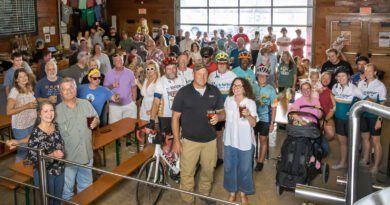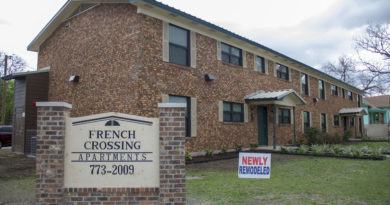Everest Rehab Bridges Gap Between Injury and Going Home
By MANDY SHELTON | Photography by YVONNE OVERSTREET and courtesy of EVEREST REHAB
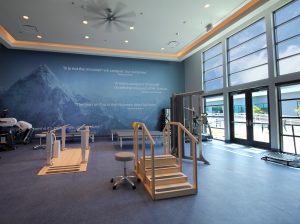 The old adage tells us that if the mountain will not come to Muhammad, then Muhammad must go to the mountain.
The old adage tells us that if the mountain will not come to Muhammad, then Muhammad must go to the mountain.
This has been true for Temple area rehabilitation patients since the closure of Scott & White’s rehab center nearly a decade ago. Someone recovering from a spinal injury may have to travel to Round Rock, Waco or College Station for an in-patient rehabilitation program, which can put undue pressure on a family. Patients often traverse Interstate 35, the occupational therapy version of the Kongma La Pass, while they are still regaining the ability to walk, much less get in a car.
The mountain has been called back to Temple with the opening of Everest Rehabilitation Hospital. The second of six hospitals slated for construction around the country, Temple’s Everest location serves to bridge the gap between traumatic injury and going home.
Each Everest facility is identical, and the iteration in Temple is $23 million and 41,000 square feet of natural light, cutting-edge equipment and visual homages to veterans. Larger-than-life statues of red pandas, native to Mount
 Everest and painted blue to match the décor, hide in corners and frequently relocate around the hospital.
Everest and painted blue to match the décor, hide in corners and frequently relocate around the hospital.
To simulate the everyday motions of homelife, Everest patients have access to a fully furnished studio apartment, where they can engage in trial runs of their daily routines. Getting out of bed, showering, opening the refrigerator and even baking cookies are all motions that can be practiced until perfect. The 36 in-patient suites aren’t too shabby, either, with 55-inch flat-screen TVs and backlit mirrors that help patients look as good as they are beginning to feel.
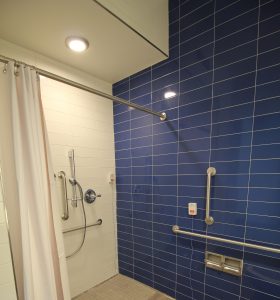 The two gyms contain top-of-the-line therapeutic exercise equipment, with an underwater treadmill sitting pride of place across from reception. If the visual is a bit murky, think of a regular old run-of-the-treadmill machine placed inside a human-sized fish tank, which can fill with up to four feet of water in less than three minutes. Hydrotherapy is easier on the joints, and the immersive treadmill eliminates the need for therapists to join patients in a pool.
The two gyms contain top-of-the-line therapeutic exercise equipment, with an underwater treadmill sitting pride of place across from reception. If the visual is a bit murky, think of a regular old run-of-the-treadmill machine placed inside a human-sized fish tank, which can fill with up to four feet of water in less than three minutes. Hydrotherapy is easier on the joints, and the immersive treadmill eliminates the need for therapists to join patients in a pool.
During the ribbon-cutting ceremony in August, a central spot in the front gym remained empty, awaiting the arrival of the antigravity treadmill (think harnesses and pulleys, not NASA) scheduled for FDA approval and due to arrive in October. Drop by the hospital to take a peek through the gym’s glass walls; the antigravity treadmill should be visible from the lobby.
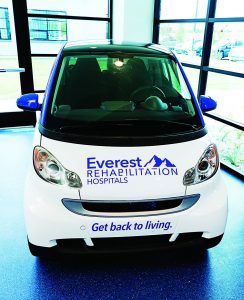 The pièce de résistance, however, addresses the first issue rehabilitation patients face when going home: getting in the car. “It’s one of those things that we as non-injured people take for granted,” said Everest co-founder and CFO Omar Jenkins. “You get in the car every day to drive to church or drive to work, and you don’t think about the actual body mechanics of getting in and out of the car until you are injured.”
The pièce de résistance, however, addresses the first issue rehabilitation patients face when going home: getting in the car. “It’s one of those things that we as non-injured people take for granted,” said Everest co-founder and CFO Omar Jenkins. “You get in the car every day to drive to church or drive to work, and you don’t think about the actual body mechanics of getting in and out of the car until you are injured.”
“Unfortunately, people who suffer certain physical injuries — it could be stroke, it could be amputation, it could a fracture of the femur — have to relearn that body movement,” Jenkins said. Everest’s mission of compassion does not require a patient to even set foot outside the hospital to practice this movement, but traditional car simulation systems — “that’s PVC pipe and a foam bench,” Jenkins explained — were not going to cut it.
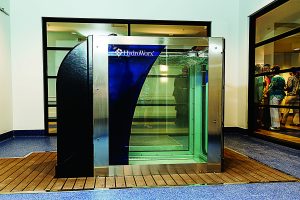 With the help of Temple High School automotive technology students, Everest simply brought a smart car inside the hospital. “We found a car that obviously doesn’t take up a lot of space but also allows someone who could be larger in size, like myself, to get in and out comfortably,” said Jenkins, a former Notre Dame football player. “We decided to bring that into the gym and use it for therapy.”
With the help of Temple High School automotive technology students, Everest simply brought a smart car inside the hospital. “We found a car that obviously doesn’t take up a lot of space but also allows someone who could be larger in size, like myself, to get in and out comfortably,” said Jenkins, a former Notre Dame football player. “We decided to bring that into the gym and use it for therapy.”
Not that Jenkins was willing to make the two-and-a-half-hour drive from his Dallas home in a smart car. “I’m used to larger cars,” he shrugged. Jenkins hitched a U-Haul trailer to his 2018 Toyota 4Runner and delivered the smart car to the auto shop at THS, handing over the keys to instructor Josh Koontz.
“He and the students there really did a great job with the car and helped us out quite a bit,” Jenkins said. As community outreach, Everest gives cars to high schools located near each of its hospitals. Often, automotive education programs struggle to source newer car parts, Jenkins explained. “When we come to them and say, ‘Hey, we have a car that your students can literally dismantle, and all we need is the body, emergency break, and steering wheel, they’re ecstatic. They get a free engine, a free transmission, and all those parts to help with their curriculum.”
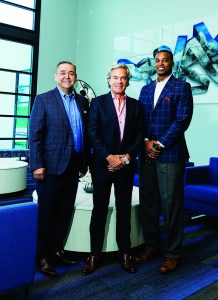 Meet Team Everest
Meet Team Everest
With a ribbon-cutting catered by RosieJo Meals and floral creations provided by Precious Memories, Everest Rehabilitation Hospital already seems part of the local landscape. So it comes as a surprise that not one of the co-founders is from the area. That hasn’t stopped CEO Jay Quintana from declaring Thai Café the best Thai food he has eaten stateside. “I’ve also been impressed with Cheeve’s,” he adds. “And Pignetti’s.” Quintana frequently distributes baked goods from Hamilton Bread Company as gifts back home in Dallas and has been impressed by the antiquing Temple has to offer.
None of the co-founders have summitted the world’s tallest mountain, though lead investor Marc Sparks has seen the view of Temple from a different Everest. “I’ve climbed to the top of this building,” the serial entrepreneur and philanthropist boasted of the hospital on the south side of Highway 36. Sparks has reason to avoid the deadly Everest: as he writes in his 2014 business memoir, They Can’t Eat You, a degenerative disc once prompted him to move a hospital bed into his office so he could continue to work through the pain.
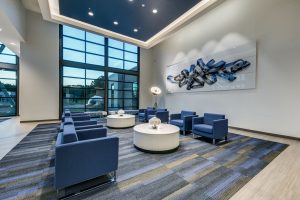 CFO Omar Jenkins, who captained the Fighting Irish football team in 2003, once ruptured his Achilles tendon, though not in the legendary Notre Dame Stadium. “It’s somewhat embarrassing because I was playing flag football,” Jenkins said. “That was my introduction to the physical rehabilitation industry.
CFO Omar Jenkins, who captained the Fighting Irish football team in 2003, once ruptured his Achilles tendon, though not in the legendary Notre Dame Stadium. “It’s somewhat embarrassing because I was playing flag football,” Jenkins said. “That was my introduction to the physical rehabilitation industry.
“I will tell people when I’m back on campus that I was skydiving,” he said. “That’s a little bit more exciting than playing flag football against undergraduate students.”
For another extreme sports story to explain away his injury, might he consider climbing Mount Everest? “Only base camp,” Jenkins said.


